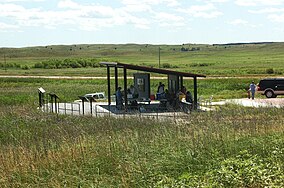Valentine National Wildlife Refuge: Difference between revisions
→Development: +image |
m Fixed typos (via WP:JWB) |
||
| Line 24: | Line 24: | ||
==Development== |
==Development== |
||
[[File:Aerial view of Valentine National Wildlife Refuge, November 2021.jpg|thumb|left|Aerial view of the refuge]] |
[[File:Aerial view of Valentine National Wildlife Refuge, November 2021.jpg|thumb|left|Aerial view of the refuge]] |
||
Collectively known as the [[Sand Hills (Nebraska)|sand hills]] region of Nebraska, the dunes were the |
Collectively known as the [[Sand Hills (Nebraska)|sand hills]] region of Nebraska, the dunes were the result of the last [[ice age]] known as the [[Pinedale glaciation]]. During the [[Holocene glacial retreat]] the sand dunes that been deposited in their current location by the vast continental glaciers, were exposed and grasses eventually took over. |
||
==Management== |
==Management== |
||
Latest revision as of 02:32, 21 April 2024
This article needs additional citations for verification. (June 2015) |
| Valentine National Wildlife Refuge | |
|---|---|
IUCN category IV (habitat/species management area) | |
 Picnic area at Valentine National Wildlife Refuge, June 2010 | |
| Location | Cherry County, Nebraska, United States |
| Nearest city | Valentine, NE |
| Coordinates | 42°29′37″N 100°34′22″W / 42.49361°N 100.57278°W |
| Area | 71,516 acres (289 km2) |
| Established | 1935 |
| Governing body | U.S. Fish and Wildlife Service |
| Website | Valentine National Wildlife Refuge |
| Designated | 1976 |
Valentine National Wildlife Refuge is located in the U.S. state of Nebraska and includes 19,131 acres (77.42 km2). The refuge protects a portion of the largest remaining area of tall and mid grass prairie in the United States.
Development[edit]

Collectively known as the sand hills region of Nebraska, the dunes were the result of the last ice age known as the Pinedale glaciation. During the Holocene glacial retreat the sand dunes that been deposited in their current location by the vast continental glaciers, were exposed and grasses eventually took over.
Management[edit]
The refuge is managed by the U.S. Fish and Wildlife Service and along with Fort Niobrara and John and Louise Seier National Wildlife Refuges, they form the Fort Niobrara National Wildlife Refuge Complex. In 1976, the Valentine National Wildlife Refuge was designated as a National Natural Landmark by the National Park Service.[1]
Natural features[edit]
Numerous lakes and ponds are located on the refuge, fed by underground seeps and springs. 260 species of birds have been identified over the years on the refuge, and during migratory periods in the spring and fall, 150,000 birds pass through the protected area. Coyote, blanding's turtle, prairie grouse, white-tailed and Mule deer are commonly found by visitors in this refuge. Muskrat and beaver inhabit the wetlands and streams.
Location[edit]
Valentine NWR is located about 20 miles (32 km) south of Valentine, Nebraska off U.S. Highway 83.
References[edit]
- ^ "National Natural Landmarks - National Natural Landmarks (U.S. National Park Service)". www.nps.gov. Retrieved 2019-03-24.
Year designated: 1976
External links[edit]
 Media related to Valentine National Wildlife Refuge at Wikimedia Commons
Media related to Valentine National Wildlife Refuge at Wikimedia Commons- "Valentine National Wildlife Refuge". U.S. Fish and Wildlife Service. Retrieved 2016-06-15.
- "Valentine National Wildlife Refuge". Recreation.gov. Retrieved 2011-08-12.
- IUCN Category IV
- Protected areas of Cherry County, Nebraska
- National Wildlife Refuges in Nebraska
- National Natural Landmarks in Nebraska
- Wetlands of Nebraska
- Landforms of Cherry County, Nebraska
- Protected areas established in 1935
- 1935 establishments in Nebraska
- Nebraska geography stubs
- Midwestern United States protected area stubs
- North Central Nebraska geography stubs


